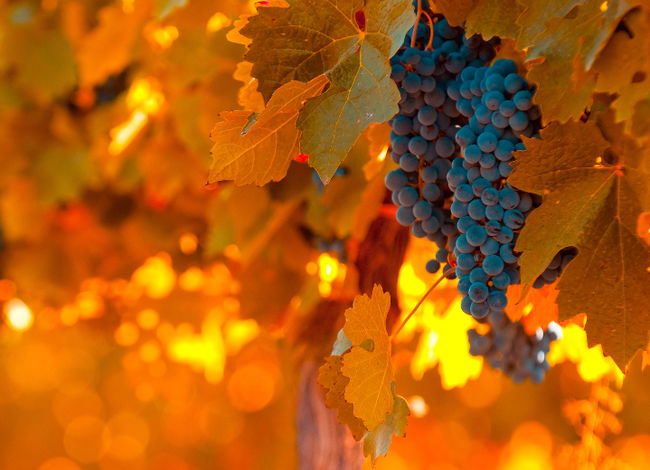Grapes as a culture known for over a thousand yearsThe name comes from the Latin word "vitilis" and means "climbing." This plant is a long-liver: even without special care in natural conditions, healthy bushes could live to 150 years! But since 1963, the phylloxera, an insect pest feeding on the roots of the plant, was brought to Europe from America. Further in the article we will learn how to care for a vineyard in the fall. What to do in October and how to carry out podzimny watering and pruning.
Table of contents
Main care activities in September and October
Modern varieties, most of which are obtained by breeding, resistant to many diseases and adapted to different climatic conditions and regions. But in order to get stable, high yields every year, improve the immunity of the grapes, keep the size of the berries and all their qualities, work should be done on preparing trees for winter:
- phased pruning;
- abundant watering;
- top dressing;
- treatment against pests and diseases;
- crockery grape roots;
- shelter plants in winter.
Let us consider in more detail what each of these actions consists in, their benefit for the plant.
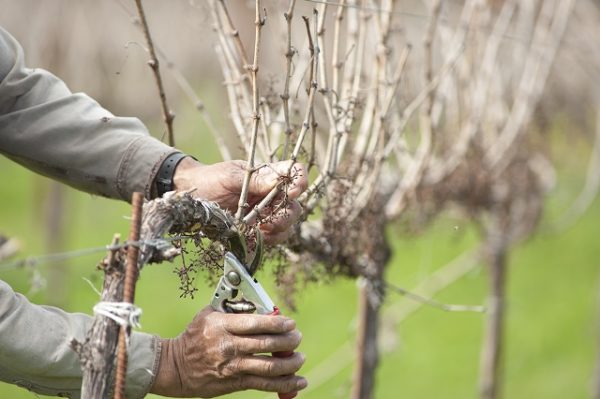
Rules of the wintering of grapes in autumn
This is a necessary event that has a very beneficial effect on the development of the plant:
- bushes are rejuvenated every year, the harvest increases significantly and the berries are much larger than those of uncircumcised grapes;
- harvest ripens faster by approximately 10 days;
- facilitated care of bushes and their treatment.
It is recommended to cut the bushes in two stages: in the middle of September and in October after the last harvest. Of course, these terms are approximate, because it is necessary to take into account the region and climatic conditions.
The first preliminary pruning is held in September. Bushes free from dry, diseased branches, which must be burned in order to avoid the spread of disease. Remove 10-15% growth shoots grown on the main trunks (sleeves) above the top wire (60 cm).
Closer to the root, in the place of branching, the replacement branches are formed annually: the growth part is left, the fruit bearing this year is harvested. The strongest young vines close to the root are pruned as follows:
- Escape from the outside of the sleeve is cut, leaving 3 buds on it;
- 1-2 shoots from the inside are left under the fruit arrow and they are cut, leaving a number of eyes equal to the diameter of the vine + 1-2 buds (for example, if the diameter is 6 mm, 7 holes are left).
If the variety gives not very large weighty clusters (up to 500g), then you can leave 2-3 more buds more.
Last autumn watering
After harvesting the grapes are watered as needed, so that the plant is not dry. If the weather is wet and rainy, then it is not necessary to water the bushes, except for one abundant moisture-charging irrigation before winter.
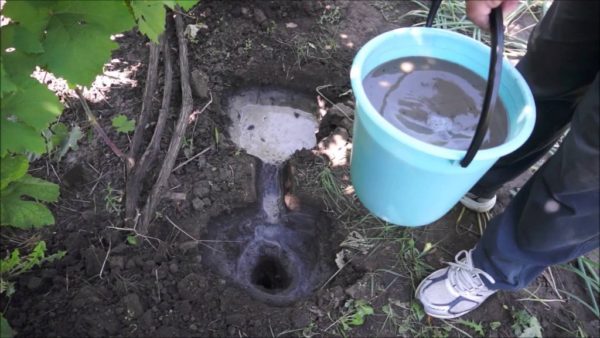
The most convenient way is to dig in the pipes during the planting of the grapes in order to use them to supply the plant with the necessary moisture and liquid fertilizers. But if you did not do this in advance, you need to make small holes or grooves around the bush so that the water does not spread, and the root is saturated with moisture as much as possible. After that, the soil must be loosened, saturate it with oxygen. These activities will help the plant to winter.
Terms of feeding for the vineyard
Fruiting, of course, takes a lot of vitality from plants, therefore, it is recommended autumn dressing during the preparation of grapes for winter. This will guarantee a good harvest in the coming year. It will be enough to add a little water solution of potash and phosphate fertilizers for each bush: potassium nourishes the root of the grapes, and phosphorus strengthens the immune system.
The soil must be loosened after irrigation and fertilization. Organic liquid fertilizers should not be applied, it is best to mumble the soil around the grape trunk with rotted manure mixed with wood ash in the winter.
How to spray crops
Immediately after the last harvest, you need to start processing the grapes with chemical solutions. Delay with this is not necessary,as pests and diseases can cause severe damage to the vines in a very short time. The processing of early varieties should be carried out without waiting for the end of the grape harvest from later varieties. Proper spraying is carried out in windless dry weather, when rain is not even foreseen.
The most effective treatment is recognized as copper and iron vitriol. If there are no traces of a fungal infection on the grapes, spraying can be divided: in the fall, process with blue vitriol (dissolve 100 g of powder in half a liter of warm water, then add the solution to 10 liters of cold water and spray it with a spray bottle), and treat the iron sulphate in early spring before bud break.
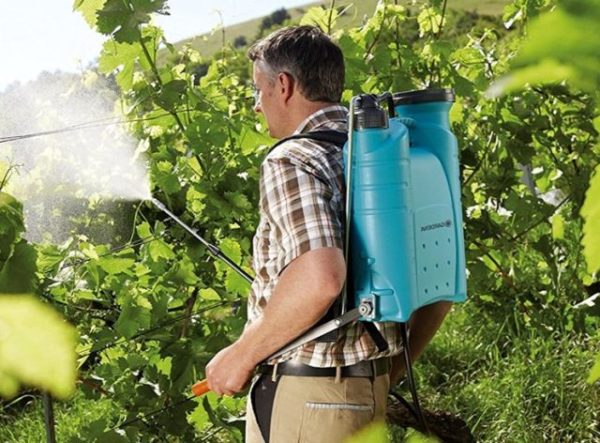
LCD very effectively fights all types of fungal diseases and saturates the plant with all necessary trace elements. Thus, the vine receives protection and foliar feeding at the same time. For the solution, it is necessary to dissolve 300 g of ferrous sulfate in 10 liters of water and abundantly spray the vine and the soil around the trunk.
If traces of the defeat of bushes with fungal infections are found in the fall, treatments with copper and iron sulphate are carried out simultaneously.
There is another option that is recommended by experts: autumnal processing on the leaves is carried out with soda-salt solution - 5 tablespoons of salt + 5 tablespoons of soda per 10 liters of water. It is necessary to spray 3-4 times in the beginning - middle of October, very carefully processing each leaf, vine and soil around the plant. In this case, the processing of copper and / or iron vitriol can be carried out immediately before the shelter of the vine for the winter.
What is and why need katarovka
The cropping of the roots of grapes is the removal of small roots that are at a depth of up to 20-25 cm from the surface, such roots are also called dews. Since they are located close to the surface of the earth, they take moisture and food from the surface layer. With the long absence of irrigation and precipitation dew roots can dry out.
In winter, even with small frosts, when the soil freezes to at least t -5about, there is a danger of their freezing. In addition, it is dew roots that are most susceptible to infection with phylloxera (a very small grape aphid, living and eating at the expense of the roots).
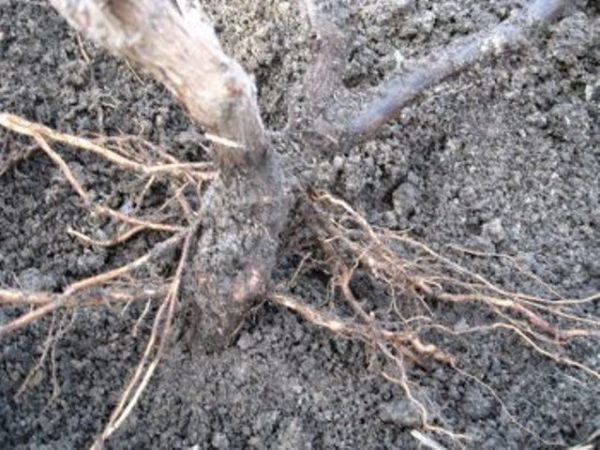
To avoid all these troubles, they perform katarovka: small roots are removed and this contributes to the development and deepening of the heel roots (deep).But this process is rather laborious and dangerous for grapes, so you need to carefully trim the roots. The roasting of the roots of young plants is carried out 2 times a year - in June and August. If the bush is not young, except for small dew roots, it can also be sufficiently thickened. Their circumcision must be done with extreme caution and gradually - over 2-3 years.
Technology: the soil around the trunk is dug to the desired depth. Sharp pruners cut the roots, leaving no knots. Sections can be disinfected with 3% copper sulphate or 1% boric acid solution, dried, and again closed the grooves with earth.
In order not to repeat this procedure every year, cut the part wrapped with a film in 2-3 layers (weakly, with a margin of 3-5 cm), or cut along a plastic corrugated hose, tied with natural twine and only then covered with earth.
For such plantings it is very important that the grapes have a developed, deeply extending root.It is not necessary to hold this event at home plots, as timely feeding, watering and shelter of bushes for the winter are possible.
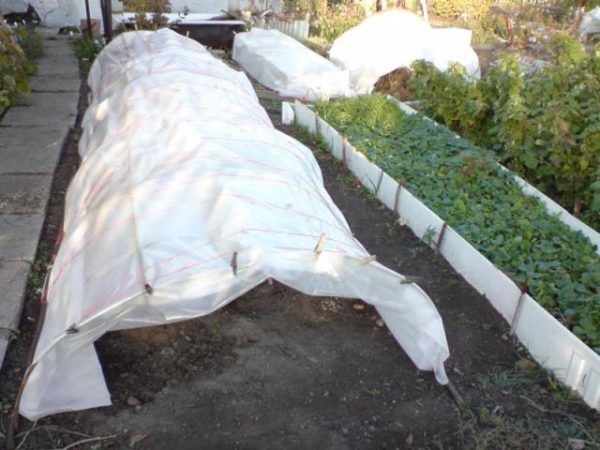
Shelter and preparation of young vines for winter
After the harvest, grape bushes cover the winter, especially if there is little snow in the area. To do this, grapevine is removed from the supports, weakly bind the branches and laid on the ground. It is best to cover the vines with spruce branches - branches of pines and firs. Such a shelter provides good air circulation, retains snow cover - creates ideal conditions for wintering.
Top can be covered with foil, leaving gaps for circulation.
All these activities are necessary to protect the culture of grapes, for a long and abundant fruiting. Whether you are in the Crimea, Krasnodar or any other regionsuitable for growing grapes. Although the vines are not very whimsical, but good care contributes to obtaining stable yields for many years - after all, grapes can grow and bear fruit for more than 100 years!
